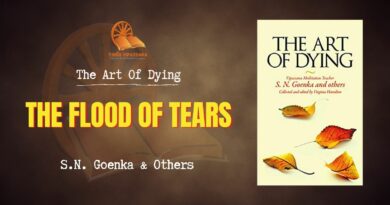Equanimity in the Face of Terminal Illness
The following article first appeared in the September 1990 Vipassana Newsletter.
About 10 years ago my wife Parvathamma was diagnosed with motor neuron disease, a rare, so far incurable, condition. She experienced a gradual wasting of the muscles of her arms, legs, and neck, and required assistance with even normal activities. Treatments by allopathic, homeopathic, ayurvedic, and naturopathic doctors produced no result. Her helplessness caused her tension and frustration. She became gloomy and wept frequently.
It was heart-rending, but everyone in the family took care that she was not put to any discomfort and that there was never any opportunity for her to feel neglected. All our efforts went toward keeping her spirits up, but she would, nevertheless, break down whenever a friend or relative called on her.
It was at this stage, about four years into the illness, that my wife attended a Vipassana course in Jaipur under the guidance of Goenkaji. She found the first day exceedingly trying, but with loving meditators around her she endured the hardship with a smile. On the fourth day, Vipassana day, she was a changed person. She experienced a flow of subtle sensations throughout her body. She was beaming with joy and felt she was even physically gaining strength. Her retreat proved to be a most beneficial 10-day sojourn.
During the following months she practiced her meditation regularly in spite of her deteriorating physical condition. Unfortunately, due to work, I had to be away in Ajmer, but whenever I returned to Jaipur I would join her in meditation. Tapes of Goenkaji’s chanting and visits by local meditators inspired and supported her.
After only one Vipassana course, her nature began to change significantly. Joy emanated from her. People who came to console her went away in peace. She never complained about her illness, nor did she express regret about her miserable condition. She made frequent loving and compassionate inquiries about the welfare of visitors and their family members, wishing them happiness and joy.
The disease progressed quickly. She experienced a rapid weakening of her muscles and was administered a glucose drip and oxygen. Although experiencing extreme pain, she still retained full control of her faculties. Her body below the neck was a pitiful heap of bones and shrunken muscles, but Parvathamma’s face beamed with a radiant smile. And she continued to meditate.
Two days before the end she ardently requested family members to pardon her for any harsh words she might have spoken while they had been attending her, and expressed her feelings of good fortune at having had such a kind and tolerant family.
The disease had by now spread to the muscles of her heart and lungs, and she was unable to sleep because she would be overcome by coughing if moved from a sitting position. She passed the next night comparatively peacefully asleep in her wheelchair. Whenever she awoke she requested those sitting by her side to take rest, and inquired whether others in the family were sleeping.
At 7:15 am she drank some milk which was followed by a bout of coughing, something she always dreaded. Feeling suffocated, she asked that I send for the doctor who arrived within 15 minutes. As he reached our doorstep her last breath exited with a little cough. On that morning of January 15, 1985, she passed away peacefully with a clear mind, bestowing compassionate glances on those around her.
We have learned from Goenkaji that our practice is also a preparation for dying; our family’s experience is a testimony to this truth. Because of her equanimity in the midst of severe suffering, my wife was in control of her faculties throughout. She was a great inspiration to everyone, and those of us who are meditators have therefore applied Dhamma more seriously. Determined effort and regular practice have helped us weather the shock of the loss of this loving being. We regularly send her mettā with wishes for her freedom from all suffering.
—Mr. S. Adaviappa









